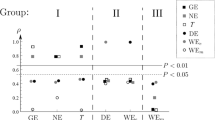Summary
Errors in measurements of mechanical work, net energy expenditure and mechanical efficiency (ME) were calculated, when subjects performed isolated eccentric or concentric muscle actions and combinations of these actions [stretch-shortening cycle (SSC) exercises] with a special sledge apparatus. The relative error of mechanical work was 6.1%. When estimating the error of energy metabolism from oxygen consumption the error would be about 4% (McArdle et al. 1981). The maximum error of ME was the sum of these two values (10.1%). Obviously the error of ME was less than 5%, because 30 muscle actions were averaged and, in addition, the errors of mechanical work and energy expenditure were not in the same direction every time. It was concluded that mechanical work can be determined accurately when the force is measured as a function of the moved distance of the sledge. Thus calculation of ME can be performed quite reliably in isolated eccentric and concentric exercises. The greatest problems were, however, in the SSC exercises, where the errors were higher, because of the problems of dividing the net energy expenditure into eccentric and concentric phases. Therefore, further developments must be made to minimize the errors in measurement and calculation during SSC-exercise.
Similar content being viewed by others
References
Abbott BC, Aubert XM (1952) The force exerted by active striated muscle during and after change of length. J Physiol 117:77–86
Asmussen E, Bonde-Petersen F (1974) Apparent efficiency and storage of elastic energy in human muscles during exercise. Acta Physiol Scand 92:537–545
Aura O, Komi PV (1986a) The mechanical efficiency of locomotion in men and women with special emphasis on stretch-shortening cycle exercises. Eur J Appl Physiol 55:37–43
Aura O, Komi PV (1986b) Mechanical efficiency of pure positive and pure negative work with special reference to the work intensity. Int J Sports Med 7:44–49
Aura O, Komi PV (1986c) Effects of prestretch intensity on mechanical efficiency of positive work and on elastic behavior of skeletal muscle in stretch-shortening cycle exercise. Int J Sports Med 7:137–143
Beckman MMC Horizon Systems (1983) Operating instructions, vol 4. Beckman Instruments, Inc. Illinois, USA, pp 1–8
Bigland-Ritchie B, Woods JJ (1976) Integrated electromyogram and oxygen uptake during positive and negative work. J Physiol 260:267–277
Bosco C, Ito A, Komi PV, Luhtanen P, Rahkila P, Rusko H, Viitasalo J (1982) Neuromuscular function and mechanical efficiency of human leg extensor muscles during jumping exercise. Acta Physiol Scand 114:543–550
Cavagna GA, Kaneko M (1977) Mechanical work and efficiency in level walking and running. J Physiol 268:467–481
Dickson S (1929) The efficiency of bicycle-pedalling as affected by speed and load. J Physiol 67:242–255
Gaesser GA, Brooks A (1975) Muscular efficiency during steady-state exercise: effects of speed and work rate. J Appl Physiol 6:1132–1139
Ito A, Komi PV, Sjödin B, Bosco C, Karlsson J (1983) Mechanical efficiency of positive work in running at different speeds. Med Sci Sports Exerc 4:299–308
Julian FJ, Morgan DL (1979) The effect on tension of nonuniform distribution of length changes applied to frog muscle fibres. J Physiol 293:379–392
Kaneko M, Ito A, Fuchimoto T, Toyooko J (1981) Mechanical work and efficiency of young distance runners during level running. In: Morecki A, Fidelus K, Kedzior K, Wit A (eds) Biomechanics VIIB. PWN-Polish Scientific Publishers, Warsaw, pp 234–240
Kaneko M, Komi PV, Aura O (1984) Mechanical efficiency of concentric and eccentric exercises performed with medium to fast contraction rates. Scand J Sport Sci 1:15–20
Komi PV, Karlsson J (1978) Skeletal muscle fibre types, enzyme activities and physical performance in young males and females. Acta Physiol Scand 103:210–218
Kyröläinen H, Komi PV, Oksanen P, Hakkinen K, Cheng S, Kim DH Mechanical efficiency of locomotion in females during different kinds of muscle contractions (in press)
Lloyd BB, Zacks RM (1972) The mechanical efficiency of treadmill running against a horizontal impeding force. J Physiol 223:355–363
McArdle WD, Katch FI, Katch VL (1981) Exercise physiology. Energy, nutrition and human performance. Lea and Febiger, Philadelphia, pp 95–104
Norman RW, Sharrat MT, Pezzack JC, Noth G (1976) Re-examination of the mechanical efficiency of horizontal treadmill running. In: Komi PV (ed) Biomechanics VB. University Park Press, Baltimore, pp 87–93
Pahud P, Ravussin E, Acheson KJ, Jequier E (1980) Energy expenditure during oxygen deficit of submaximal concentric and eccentric exercise. J Appl Physiol 49:16–21
Pierrynowski MR, Winter DA, Norman RW (1980) Transfers of mechanical energy within the total body and mechanical efficiency during treadmill walking. Ergonomics 23:147–156
Scholander PF (1947) Analyzer for accurate estimation of respiratory gases in one-half cubic centimeter samples. J Biol Chem 167:235–259
Whipp BJ, Wasserman K (1969) Efficiency of muscular work. J Appl Physiol 26:644–648
Author information
Authors and Affiliations
Rights and permissions
About this article
Cite this article
Oksanen, P., Kyröläinen, H., Komi, P.V. et al. Estimation of errors in mechanical efficiency. Europ. J. Appl. Physiol. 61, 473–478 (1990). https://doi.org/10.1007/BF00236070
Accepted:
Issue Date:
DOI: https://doi.org/10.1007/BF00236070




